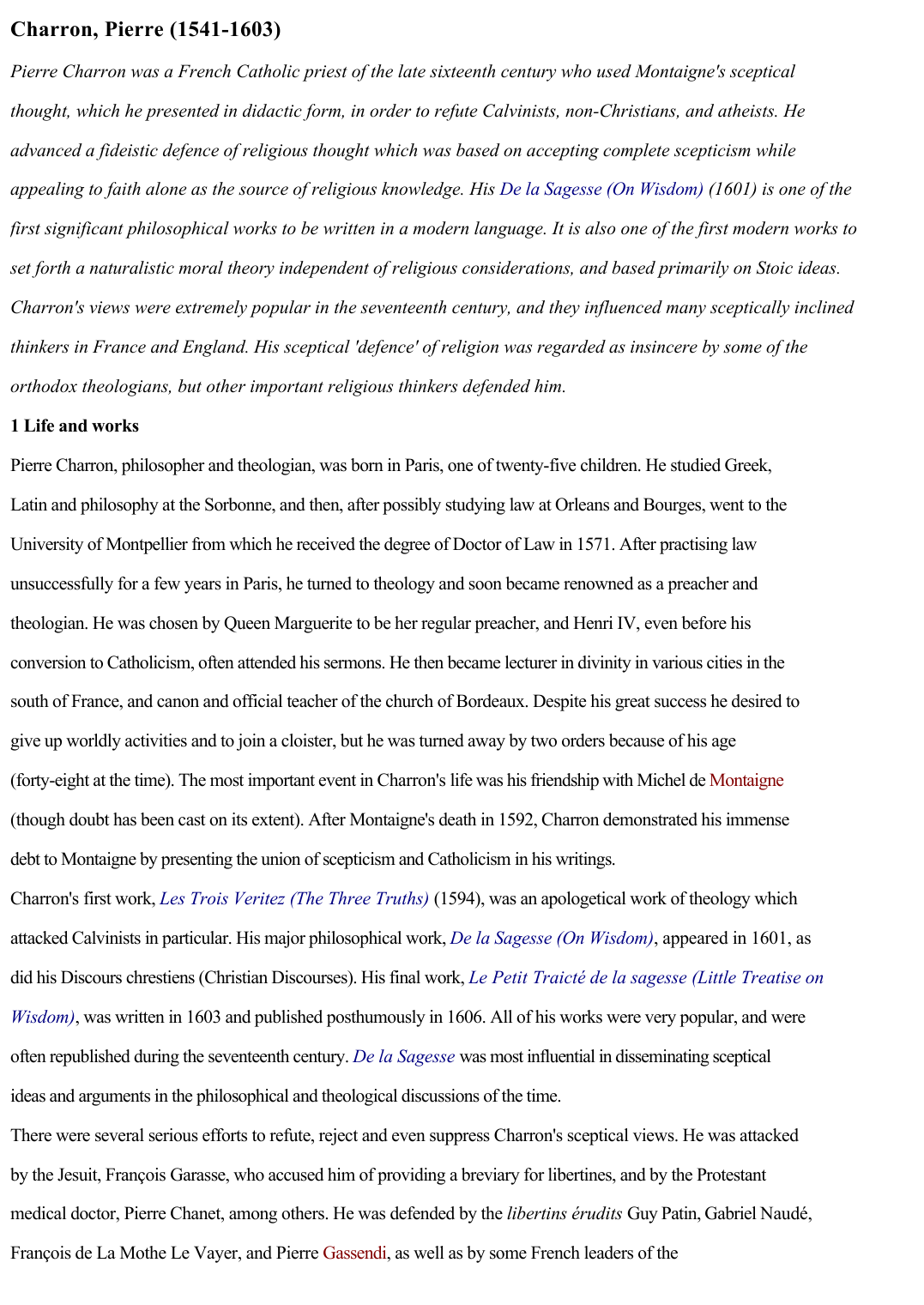Charron, Pierre
Publié le 16/05/2020

Extrait du document
«
Charron, Pierre (1541-1603)
Pierre Charron was a French Catholic priest of the late sixteenth century who used Montaigne's sceptical
thought, which he presented in didactic form, in order to refute Calvinists, non-Christians, and atheists.
He
advanced a fideistic defence of religious thought which was based on accepting complete scepticism while
appealing to faith alone as the source of religious knowledge.
His De la Sagesse (On Wisdom) (1601) is one of the
first significant philosophical works to be written in a modern language.
It is also one of the first modern works to
set forth a naturalistic moral theory independent of religious considerations, and based primarily on Stoic ideas.
Charron's views were extremely popular in the seventeenth century, and they influenced many sceptically inclined
thinkers in France and England.
His sceptical 'defence' of religion was regarded as insincere by some of the
orthodox theologians, but other important religious thinkers defended him.
1 Life and works
Pierre Charron, philosopher and theologian, was born in Paris, one of twenty-five children.
He studied Greek,
Latin and philosophy at the Sorbonne, and then, after possibly studying law at Orleans and Bourges, went to the
University of Montpellier from which he received the degree of Doctor of Law in 1571.
After practising law
unsuccessfully for a few years in Paris, he turned to theology and soon became renowned as a preacher and
theologian.
He was chosen by Queen Marguerite to be her regular preacher, and Henri IV, even before his
conversion to Catholicism, often attended his sermons.
He then became lecturer in divinity in various cities in the
south of France, and canon and official teacher of the church of Bordeaux.
Despite his great success he desired to
give up worldly activities and to join a cloister, but he was turned away by two orders because of his age
(forty-eight at the time).
The most important event in Charron's life was his friendship with Michel de Montaigne
(though doubt has been cast on its extent).
After Montaigne's death in 1592, Charron demonstrated his immense
debt to Montaigne by presenting the union of scepticism and Catholicism in his writings.
Charron's first work, Les Trois Veritez (The Three Truths) (1594), was an apologetical work of theology which
attacked Calvinists in particular.
His major philosophical work, De la Sagesse (On Wisdom) , appeared in 1601, as
did his Discours chrestiens (Christian Discourses).
His final work, Le Petit Traicté de la sagesse (Little Treatise on
Wisdom) , was written in 1603 and published posthumously in 1606.
All of his works were very popular, and were
often republished during the seventeenth century.
De la Sagesse was most influential in disseminating sceptical
ideas and arguments in the philosophical and theological discussions of the time.
There were several serious efforts to refute, reject and even suppress Charron's sceptical views.
He was attacked
by the Jesuit, François Garasse, who accused him of providing a breviary for libertines, and by the Protestant
medical doctor, Pierre Chanet, among others.
He was defended by the libertins érudits Guy Patin, Gabriel Naudé ,
François de La Mothe Le Vayer, and Pierre Gassendi , as well as by some French leaders of the.
»
↓↓↓ APERÇU DU DOCUMENT ↓↓↓
Liens utiles
- COMMENTAIRE DE TEXTE : “Stances à Marquise”, Pierre Corneille (1658)
- Mignonne - Pierre de RONSARD
- Carnet du Lecteur Mignonne, allons voir la rose de Pierre de Ronsard
- Sven Ortoli et Jean-Pierre Pharabod : Cantique des quantiques (résumé et analyse)
- Jean-Pierre Luminet: L'Univers chiffonné


